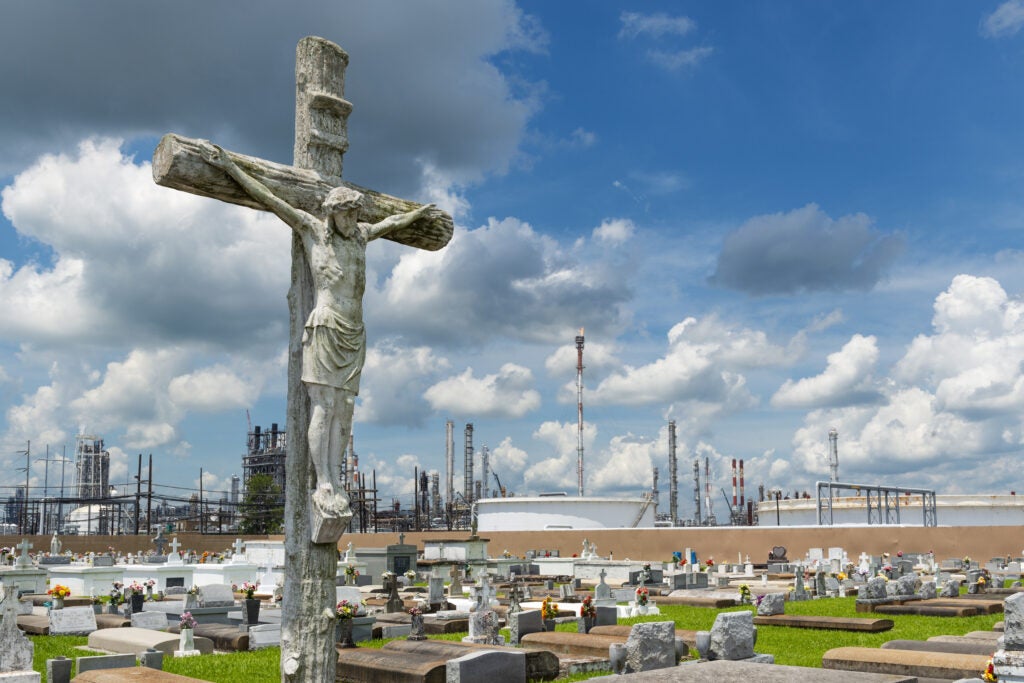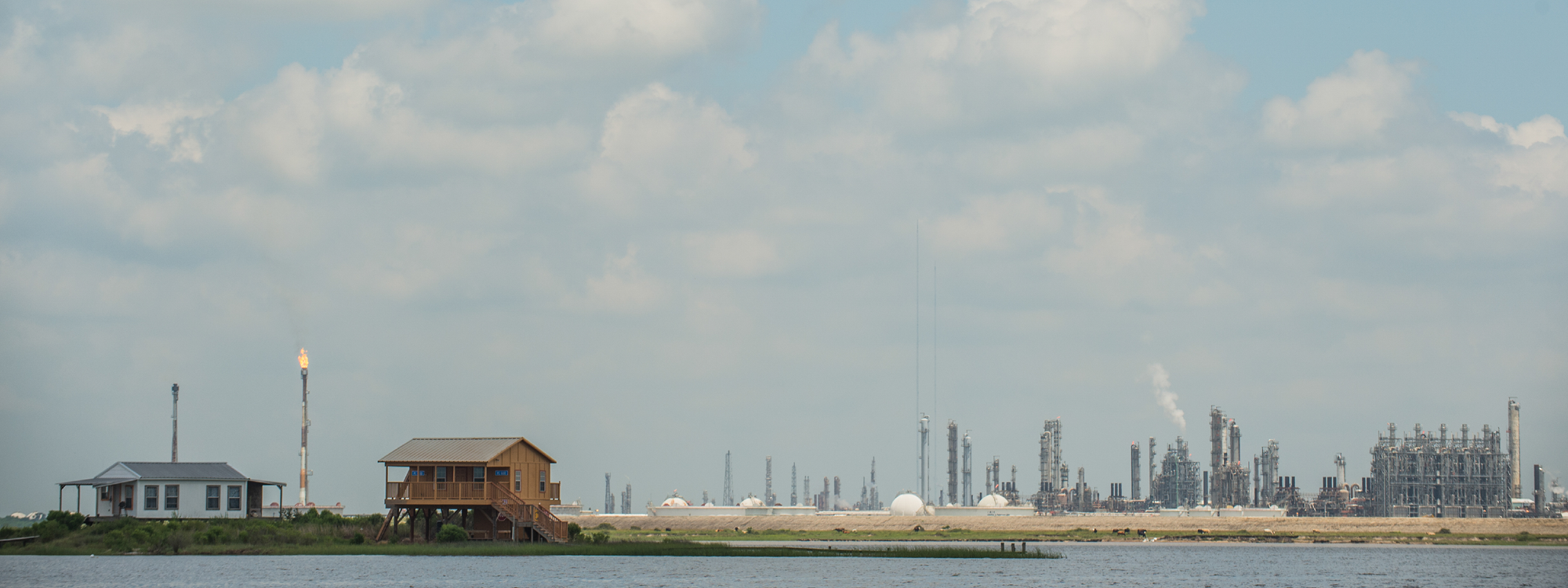The Silo: Toxic Racism
Georgetown scholars share their perspectives on environmental racism
This issue, Georgetown scholars Tiffany Ganthier, Laura Anderko, and Sheila R. Foster share their perspectives on environmental racism.

The Silo is a series that explores an environmental topic from multiple angles, engaging experts from divergent backgrounds and disciplines. Together, their well-rounded analysis offers the opportunity to expand our understanding of a complex issue.
How does your work relate to environmental racism?
Tiffany Ganthier:
At the Georgetown Climate Center I focus on equitable climate adaptation. Climate change does not affect all people equally. Low-income communities and people of color are hit first and worst by climate impacts such as extreme heat and flooding. Struggling communities also receive fewer resources for recovery, so disasters push many into a downward spiral of poverty and vulnerability. As this truth is becoming more and more apparent, many local governments and community-based practitioners are incorporating principles of equity into their climate adaptation planning and implementation. To help communities address challenges of climate resilience and social inequality, in addition to providing place based support, GCC released an Equitable Adaptation Legal & Policy Toolkit. It includes best emerging practices, legal and policy tools, and case studies to help users explore solutions linking equity and resilience.
Laura Anderko:
Currently, I hold the Scanlon Endowed Chair in Values-Based Health Care position with Georgetown’s School of Nursing and Health Studies (NHS), which focuses on values such as the common good and social justice. My current work focuses heavily on environmental racism and environmental justice (EJ). As Co-Director of the Mid-Atlantic Center for Children’s Health and the Environment, I’ve worked closely with EJ communities to identify and address environmental burdens. Other examples include courses I teach that address environmental racism such as Population Health, and a course I’ve co-taught with Dr. Rosie Sokas on Environmental Justice (EJ) and how it relates to health.
I first got started in this work in the early 1990s when I was director of the Home Health Agency. We had a contract with the State Health Department for Adverse Pregnancy Outcome Reporting Systems. I worked on a case with a baby that had been born with a brain stem but no brain. I visited the mother and conducted an assessment to try to determine if there had been any harmful exposures (e.g., smoking, drugs)—and there were none. Later, I noticed that the house was located in an area that was highly polluted, with many factories on the adjacent river. I realized that this was a typical EJ situation, although it wasn’t called that at the time. I started exploring the research and connected with nurses across the country who were involved in environmental health, starting my own journey in this new field.
Sheila R. Foster:
For most of my career, I have worked on issues of environmental racism, meaning, I’ve worked on how local governments, state governments, and the federal government can best respond to the disproportionate burden that low income communities of color bear. This is largely with regard to pollutants, toxins, and what we might call locally unwanted land uses such as waste facilities, incinerators, and other hazards that may be in the home like lead paint or contaminated land left over from industry or exposure to air pollution. So I have worked on policies, in some cases brought lawsuits, and also worked with community groups on these issues over the course of my career.
How does your discipline define environmental racism?
Ganthier:
Environmental racism is the disproportionate impact of environmental risks on people of color; particularly black and brown people who have long been marginalized. Climate change is a threat multiplier for the effects of environmental racism. Environmental justice is the communities’ response to environmental racism. The practice of equity requires the recognition that we are not starting from the same place due to historic and present systems of oppression. Environmental equity can be described as the government’s response to the demands of the environmental justice movement. Equity is about reapportioning or redistributing resources so people can access opportunities. Justice is about dismantling the barriers to those opportunities.
Anderko:
Environmental racism derives from systemic, societal racism with policies and politics that impact people disproportionately with increased burdens of industry and pollution in their communities. Environmental racism is prevalent today and remains strong despite efforts to reverse its course. It is seen in the communities of color that live in the most polluted neighborhoods, the communities of color that live in substandard housing, and the communities of color that cannot get decent nutritional food. It is systemic, it is societal, it is built into our political laws, and it is complex. But it is not impossible to defeat.
Foster:
The accepted definition for environmental racism is that it occurs when certain communities bear a disproportionate share of environmental hazards while also disproportionately lacking environmental benefits and amenities such as green space, parks, or bike lanes. It is also connected to the structure and systemic racism that is often present or manifest in these communities. So I see environmental racism as one more manifestation of structural disadvantage and systemic racism. Environmental racism leaves these communities with the lack of access to good food choices, quality and affordable housing, employment opportunities, or lacking local amenities, including sidewalks or good roads. Pollution is just another manifestation of that because it’s connected to all of these other ways that these communities have been left behind and ignored.
What current event demonstrates where and how environmental racism plays out today?
Ganthier:
This August, Hurricane Laura, a strong category 4 storm, struck the Gulf Coast in the heart of a U.S. petrochemical hub. Even under normal conditions, residents of majority-minority communities are regularly exposed to high levels of toxic air pollution that has been linked to increased levels of cancer and respiratory disease. Storm damage led to a chlorine leak at a swimming pool chemical manufacturing facility. That leak, in turn, ignited fires in surrounding facilities, which released chlorine gas. The toxic smoke that was released into the air forced Louisiana’s governor to warn residents to turn off their air conditioners, seal off their windows and doors, and stay inside.
In addition to the toxic exposure, many of these same communities of color were not afforded the same means of storm protection for their properties and evacuation as wealthier, predominantly white communities nearby. According to Louisiana State University, someone could pay $7,000 for 100 feet of tubing that will create a 4-foot-tall barrier around their home. Many wealthier residents in the Lake Charles area did so while their low-income neighbors who could not evacuate sheltered-in-place and braved out the stormwaters without inflatable barriers until the situation was safe enough for rescue teams to arrive. Hurricane Laura highlighted the contrasting experiences of dealing with a climate disaster in the face of environmental racism and classism
Anderko:
There has been a movement growing around righting the wrongs of racism and environmental racism. A lot of this has grown as a result of the killing of George Floyd. It will take time to disassemble the unfair laws and structural racism, but small steps are being taken. For example, a number of environmental groups are changing the way that they conduct business. They are increasing the number of people of color on their advisory groups and their boards. Many of these organizations are hosting events with communities of color and national leaders to address environmental racism. It is important to educate leaders who can move the country in ways that will get us to where we need to be faster. This article highlights many of the themes from these movements, and places emphasis on the importance of community partnerships in promoting environmental justice.
Foster:
I think Flint, Michigan, with the water crisis demonstrates a classic example of environmental racism. There was a low-income and predominantly African-American city where certain decisions were made at the state level that manifested a reckless disregard, or even an intentional disregard, of the health of these communities. In fact, these decisions tolerated and perhaps even intentionally desired that these communities be the sacrifice for larger decisions such as saving money at the state level. So Flint, Michigan, the water crisis is kind of a classic example. I think of the interaction between systemic racism and environmental racism taking on a large role in this case.
What systems or groups does environmental racism benefit, and who suffers most?
Ganthier:
Social, economic, and political systems in the United States have routinely advantaged white and wealthy residents. For example, U.S. slavery and racial segregation led to entrenched education and job disparities, lack of investment in public transit and other services, and race-based housing segregation and exclusionary zoning practices. Those, in turn, have contributed to landscapes in which low-income, black and brown people and immigrants live in places that are more susceptible to sustained exposure to air pollution and water contamination. They also have limited access to healthcare. Those impacts represent the very definition of marginalization: “the process of according less importance to something or someone moved away from the inner workings of the group.”
Anderko:
Environmental racism at its core is societal. It is how we have built our society to benefit one group of people over another—and it tends to be minority groups such as Native Americans, African Americans, or Latinx that are most marginalized and overburdened. Our society is built on the shoulders of people who we have used to gain our wealth, to gain what we think of as the American way of life. Our laws are not designed to protect all people from the hazards of environmental contamination.
Most of those consumption choices and patterns are not paid by all of us as a society, but rather externalized to the most vulnerable of us, whether intentional or not.
SHIEILA R. FOSTER
Foster:
If you think about our consumption as a society, we consume a lot of things. Technology, technological products, clothes, many things that are disposable, and a lot of plastics. As a society, we have to do something with all of those things in order to support our consumption habits.
Most of those consumption choices and patterns are not paid by all of us as a society, but rather externalized to the most vulnerable of us, whether intentional or not. Low-income, poor, minority communities therefore lose the most. Those who gain the most, on the other hand, are those who consume the most and do not internalize the cost of their consumption decisions. They do not think about how their consumption choices pollute our global commons, and they don’t have to live with waste facilities in their backyards.

How is this term misused? How do you wish it were better understood?
Ganthier:
Many people do not realize that environmental racism exists in many forms. The chemicals released from “Cancer Alley” in Louisiana, the traffic pollutants that create “Asthma Alley” in the Bronx, New York, or the failed treatment of the municipal water system in Flint, Michigan, are all the results of environmental racism. It has been occurring all over this country for as long as it has existed and now is a better time than any to work together to end it.
Anderko:
I wish people understood better the need to have a focus on public health and social determinants of health—and how this can lead to inequities. Public health is fundamentally about keeping people well, by protecting and promoting health. If we take an EJ stance that looks at social determinants of health, and how we have to consider the economy, housing, and more, we will be better able to address environmental racism. Also, if we only focus on healthcare, it means people are already sick from an environmental exposure. If somebody has been exposed to a point where they are sick, we have already lost the battle.
SF:
One misunderstanding is that racism always involves malice or intent to harm a particular group. As we know, that can be the case, but the word systemic means that a lot of the racism that we do have is baked into the system, in part, because of legacy decisions that have never been remediated. It’s not just examples like Flint where there was awareness about what was happening but no action. In most cases of environmental racism, it’s a corporate or state actor looking to make a decision to get rid of waste, to avoid clean up, or to disregard investments because they think it’s economically rational. So in those cases there’s not malice or harmful intent, but yet they are benefiting off of an already unfair, unjust, systemically, and structurally racist system that allows them to do that with ease. If you never bring that system under interrogation then these outcomes will continue. People will continue to make economically rational decisions that further lock-in this kind of racism. So I think a misunderstanding to think racism only means that you’re out to harm a group.
Is there an approach against environmental-racism that encourages you?
Ganthier:
Addressing environmental racism in the context of climate policy involves strengthening community resilience while ensuring that equity is integrated into policies and practices. In practice, this means building equity into every part of climate resilience planning and implementation, addressing the disproportionate impacts that affect frontline communities, and working to dismantle barriers that have prevented frontline communities from thriving. This involves thinking of equity as including both inclusive processes that give frontline communities opportunities to shape decision making and a deep investment in implementing the programs and policy solutions that frontline communities ask for and need.
Anderko:
EJ communities must be “at the table” to inform and advise how best to address environmental racism, and there needs to be resources behind any solutions. Any solution must be committed to protecting people and aiming towards health equity through an honest evaluation of our current systems and policies.
Foster:
Most advocates in the environmental justice world think that the solution to environmental racism is not a discrete solution, but rather it’s connected with all the other issues that characterize the communities in which George Floyd was killed. The solution to higher levels of police brutality and a host of other systemic problems is also the solution to the environmental racism problem. It is also connected to the climate injustice problem because these communities are vulnerable to flooding and they tend to live in lower lying areas. They are also exposed to heat waves because they lack access to air conditioning and healthcare that can help them in a climate crisis.
All of these things are wrapped up with each other. We’ve come to appreciate that you can’t discreetly address one without addressing the root causes of all of them. That’s what I think it’s so helpful when activists—such as those within Black Lives Matter and climate movements—look at these problems in an intersectional way. We are starting to think of climate justice as racial justice, environmental justice as racial justice, racial justice as environmental justice, racial justice as climate justice, racial justice as housing justice, et cetera. I think that is where the understanding is moving, so the solution to all of these problems are systemic and structural and that’s the level at which we have to be working to suggest solutions.

